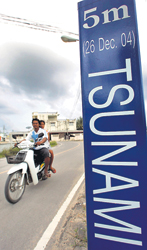
|
Warning system? Only talking BANGKOK, (AFP) - Nearly two years after the tsunami, a regional warning system is beset by squabbling and inaction, officials and experts say, as individual countries instead scramble to implement their own schemes. Thailand this month released a US-funded deep-sea warning buoy into the Indian Ocean, while Indonesia plans to install about 15 similar devices. But persuading the counties to work together, overseen by the United Nations' Intergovernmental Oceanographic Commission (IOC) is proving trickier.
"(The IOC) keep talking, they keep discussing, they organise a meeting (but) there is no solid outcome, nothing is happening," said Smith Thammararoj, head of Thailand's National Disaster Warning Centre. Nations around the Indian Ocean were taken completely unaware when an earthquake off the coast of Indonesia sent towering waves sweeping across the coastlines of 11 counties on December 26, 2004, killing about 220,000 people. Determined to avoid a repeat of the catastrophe, affected countries and donors came up with a regional solution similar to the Pacific Warning System, which has its headquarters in Hawaii. But two years have passed and the region still cannot decide which country will host the Indian Ocean regional warning centre, with India, Thailand, Indonesia, Malaysia and Australia vying for the post. "They still argue which country will be the best one," said Smith, adding that UN subsidies for the country that hosts the centre were proving an incentive. Smith said that Thailand had installed 90 watch towers along the coast and a well-equipped national warning centre. Indonesia, meanwhile, has tested an early warning system and plans to install up to 15 German-funded warning buoys and more than 100 seismographs by 2009. But other countries are falling behind. India is yet to deploy an early warning system -- but has said it hopes to have one up and running along its coast by September 2007. Sri Lanka, where 31,000 people were killed, is also still without its own tsunami warning system -- although the newly established National Disaster Management System has set up direct links with the US Geological Survey to track earthquakes. The original timescale for implementing the region-wide warning system was mid-2006, but that deadline has passed with much left to achieve, including the installation of 23 more deep-sea warning buoys in the Indian Ocean. "They are much more prepared, sending messages to coastal areas when important information comes, but a lot more still needs to be done," said a US expert working in the field, who wished to remain anonymous. He said that the IOC would grant the regional centre to the first country whose national centre meets their standards, but added that it would take years before any of them reached that stage. "It's still very political," he added. The United Nations Education, Scientific and Cultural Organisation said in June that the regional warning system was running as scheduled, with a network of 26 national tsunami information centres set up around the Indian Ocean. |
| || Front
Page | News
| Editorial
| Columns
| Sports
| Plus
| Financial
Times | International
| Mirror
| TV
Times | Funday
Times || |
| |
Copyright
2006 Wijeya
Newspapers Ltd.Colombo. Sri Lanka. |
